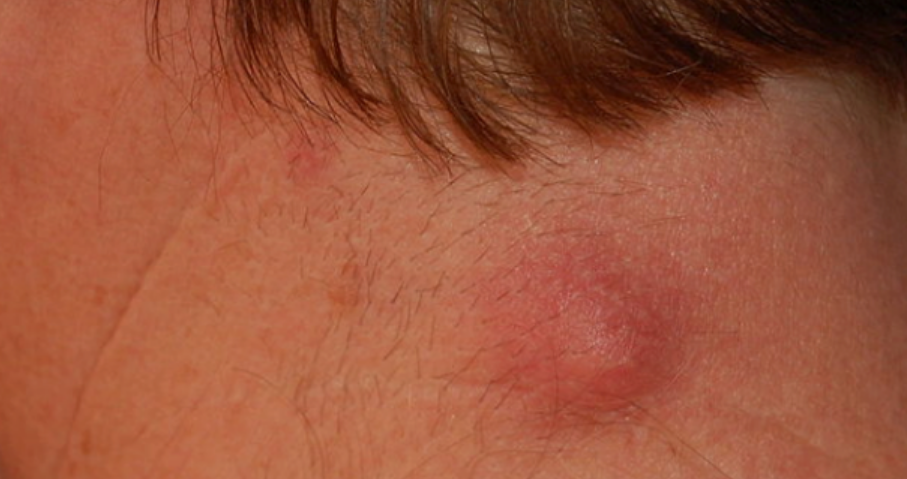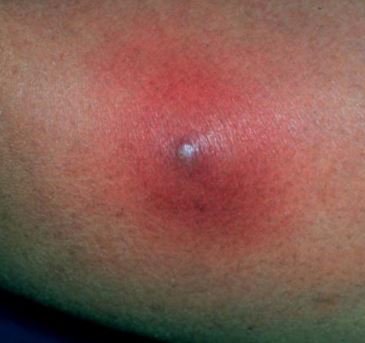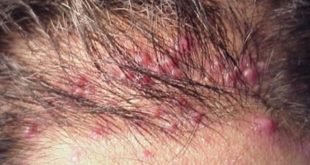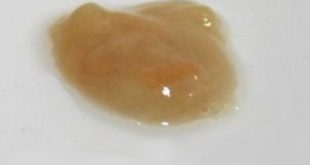Even though an infected sebaceous cyst is not cancerous, it can be very irritating. An infected sebaceous cyst is a small bump or lump appearing under your skin. In many cases, this type of cyst is found in areas such as the upper chest, upper back, neck, and face. The following are the symptoms associated with this type of lump, as well as tips on how you can go about removing or treating the lump.
An infected sebaceous cyst begins to develop when the oil producing glands found on your skin surface become blocked, leading to the creation of hollow sacs, that are filled with fatty, yellowish substances, which have the appearance of cottage cheese. Often, you will find that the cysts are made up of swollen lumps or hair follicles, which come about when the skin is traumatized.
In many cases, this type of cyst develops at a very slow pace, and is usually not painful in any way. But, you should not that it can become infected or inflamed. When this happens, it means that the overlying skin will become reddish, tender, and very sore.
Pictures of infected sebaceous cyst
Contents
- Pictures of infected sebaceous cyst
- Infected sebaceous cyst on back, breast, and face
- What is an infected cyst?
- Causes of sebaceous cysts and infections
- Infected sebaceous cyst on head and scalp
- Symptoms of Infected sebaceous cyst
- Antibiotics for treating infected sebaceous cyst
- Home treatment for infected sebaceous cyst
- References;
Here are pictures of infected dermoid and sebaceous cysts.

Infected sebaceous cyst on back, breast, and face
A sebaceous cyst, or an infected sebaceous cyst could result in a lump that is tender and warm. The affected skin area could become red as a result of the inflammation that is associated with this kind of lumps. In the human body, some of the areas that are prone to this kind of cyst infections include the neck, back, and face.
Also known as epidermoid cysts, they appear under your skin surface in the form of small lumps. According to Medscape, the sebaceous cysts can occur on any part of your skin, but they are most commonly found in the trunk, scalp, neck, and face.
- These cysts grow at a slow pace, and are not easily discoverable until they become bigger, at which point you will be able to feel them under your skin
- Sebaceous cysts occurring under your skin are normally painless, but they could start to hurt when they become infected, or when you suffer from trauma, which could force these cysts to rapture.
- According to Mayo Clinic, many people refer to epidermoid cysts as sebaceous cysts, despite the fact that they are very different.
Even though the sebaceous cysts are quite harmless, and will normally not require any kind of treatment, when it becomes infected, you will be forced to seek medical attention. Before looking at the home remedies, as well as the treatment options that are available, let us first look at what causes the infected cysts to occur on the face, back, legs and breasts, as well as the symptoms manifested.
What is an infected cyst?
Infected cysts on the skin surface come about when the oil producing glands are blocked. When they become blocked, a hollow sac is left behind, which is then filled with a yellowish looking substance, which also happens to be fatty or oily. In case bacteria gets introduced into this area, the lump that has formed under your skin will become infected.
It is important to understand that the infected sebaceous cysts could grow into an abscess, which would then end up causing you a lot of pain, not forgetting the fact that pus may start oozing out from it. In some cases, infections could occur, and this could cause the appearance of lesions that are dome shaped, which arise when a pilosebaceous follicle is raptured.
- The neck, legs, face, and breasts are the areas that are most likely to get infections. The reason for this is because it is very easy to reach these areas, which makes it easy for a person to introduce viruses and bacteria to the cysts when they are trying to pop them.
- Before a cyst becomes infected and starts turning into a tender abscess and lesion, the cyst will be slightly movable, and you will feel as though you are touching a movable lump under your skin surface.
- If you notice that a cyst has become painful, there is a good likelihood that it has already become infected.
You can also get an infected sebaceous cyst from an ingrown hair in any of the areas mentioned above. Normally, the ingrown hairs form when the hairs starts to grow back into your skin. You will often notice that they cause a lot of irritation, and may lead to the area becoming infected, or inflamed. Before the ingrown hairs can turn into cysts, the ingrown bumps will usually be hard, and may develop into very hard sebaceous cysts, which are quite common in the pubic region.
Causes of sebaceous cysts and infections
Accumulation of oily substances as well as keratin that has been trapped under the skin surface are the primary causes of sebaceous cysts. Once the dead skin cells start to move deeper into your skin, they will start to form a cyst.
According to Everyday Health, the cells forming the walls of these cysts normally secrete a protein, known as keratin into the sebaceous cysts. Once this has taken place, the end result is that a bump will be formed under your skin, which will continue to grow bigger and bigger with each passing day. Often, the size of the cysts will vary between small and pea sized sebaceous cysts.
According to the United States National Library of Medicine, the cysts in some people can be inherited. For instance, Steatocystoma multiplex is a disorder (congenital), which could lead to the appearance of many cysts all over your body.
An ingrown hair is another known cause of the sebaceous cyst. This kind of cysts will normally develop in the form of ingrown hair bumps, which with time then transform into full blown cysts. In such a case, this type of cyst will be infected. It normally starts when your hair follicle becomes inflamed and swollen because of bacterial infections and trauma.
You should ensure that you take note of any hard lumps appearing under your skin. Even though the epidermoid and sebaceous cysts are non-cancerous or benign, bumps appearing under your armpit, in the neck area, genital region, or jawline, could be a sign that you have cancer, and as such, they should be checked out, instead of being ignored.
Infected sebaceous cyst on head and scalp
Sebaceous cysts on head and scalp are also known as pilar cysts or trichilemmal cysts. These are cysts filled with keratin, and which often originate from your outer root hair sheath. In the human body, keratin is the protein responsible for making the nails as well as the human hair. It therefore, comes as no surprise that the pilar cysts are found on the scalp, and are more prevalent in middle-aged females.
In most cases, you will find that this particular type of cyst runs in the family, and are therefore inherited. They can be passed to a child of either gender, and each child has a 1 out of 2 chance of inheriting this condition from the parents. If these pilar cysts are not causing any symptoms, it will not be necessary for you to have them removed. But, drainage and incision under the local anesthesia can assist in providing comfort to the affected individual.
Symptoms of Infected sebaceous cyst
A skin cyst is nor harmful, unless it becomes infected. It is imperative to note that sebaceous cysts are not similar to ingrown hair cysts or acne cysts, which are normally known to cause a lot of pain to an individual. In most cases, the sebaceous cyst appearing on your legs, face, pubic area, as well as your neck is nothing more than an aesthetic problem.
However, you will find that many people prefer having the cysts removed, even though they are pretty much harmless. You should ensure that you see your doctor as soon as you have noticed any alarming symptom, which could be an indication that you have an infection under the skin surface. There are bacterial infections that can be quite dangerous, hence the need to have them checked out. Below are some of the symptoms associated with an infected sebaceous cyst.
Boils or abscess

Boils and abscess often form on the buttocks, as well as on the inner part of your thighs. They will normally grow from the infected bumps and pimples on your inner thighs. The abscess could begin from a sebaceous gland that is clogged. For instance, cysts occurring behind your earlobes could begin from mastoiditis or infections.
- A boil or abscess resulting from a cyst (sebaceous) can be very painful
- There are boils known to ooze a cheesy like fluid. The fatty substance also happens to have a very foul smell.
- It is common for boils to develop when sebaceous cysts have been formed from hair follicles that are infected.
- According to WebMD, boils are skin infections, which starts from oil glands or hair follicles.
A few days after you have been infected, pus cells will start to collect inside this hollow sac. When this happens, lesion or abscess could start turning yellowish or whitish in color. There are certain boils, which may appear greenish in color, more so when this infection becomes severe, and starts to advance. It is recommended that you see a doctor as soon as you notice this particular symptom. The doctor will be able to drain the cyst, thereby preventing the occurrence of any more infections.
Burst cyst under your skin surface
Infected sebaceous cysts could end up bursting, and this could lead to a person experiencing a lot of pain. There are certain cysts that become big, to the extent that they start applying pressure to the skin surface. These kinds of cysts could end up bursting, if keratin is continuously deposited into the growing cyst, thereby making it to become bigger and bigger.
Trauma is the other reason for burst cysts. If the affected individual keeps on disturbing and picking on the cyst that is below the skin surface, it will start to become loose and tender. As a result, it could become inflamed. Once inflamed, it may end up bursting, and in the process, release all its contents on to the skin surface.
- There are cases where this lump bursts, thereby causing this bacterial infection to start spreading to all the other skin tissues.
- In case the infection begins to spread, there is a chance that you may start to experience bleeding, a high fever, as well as pain.
- According to Fertility Chef, majority of the cysts that burst open are the ovarian cysts. Given that the fluids continue to build up inside the cyst, it is inevitable for the ovarian cyst to burst open.
Whether infected or not infected, when an ovarian or sebaceous cyst bursts open, the affected person can expect to experience a lot of pain. Additionally, bleeding should also be expected, although the bleeding will most likely follow the pus that will start oozing from this particular lesion.
Bleeding or oozing pus
Sebaceous cysts can be tender or hard. You will find that the hard cysts hardly ever get infected, while the tender cysts have a higher chance of becoming infected, which may then cause bleeding, fever, as well as pain. Infected epidermoid or sebaceous cysts will normally produce pus in the event that they become raptured or they burst open.
- When raptured, the pus oozing from the cyst could smell bad, or the cyst could produce a cheesy looking substance.
- This is brought about by the oil found in the sebaceous gland, which has become trapped, and as such starts to rot inside this cyst.
- Depending on the cause, blood could also be a part of this cyst.
Fever and pain
Once you get an infected cyst on the face, leg, skin, or your inner thighs, there is a chance that you will start to develop additional symptoms related to this infection. Common indicators of an infected cyst (epidermoid) include fever, aching, as well as pain.
The symptoms could be accompanied by inflammation as well as redness. As such, when you notice that the cyst is producing such symptoms, there is a likelihood that this infection has started to spread to the other surrounding tissues, making it necessary to seek medical advice.
Antibiotics for treating infected sebaceous cyst
Many infections that occur in the epidermoid cysts are normally brought about by bacteria. In such a case, the doctor will need to treat this infection, before he or she can proceed to remove the cyst from below your skin surface. Remember that infected cysts are extremely tender, and have a redness that often extend below the cavity of the cyst.
- For excision to be done, the bacterial infection must be treated first
- Many infections affecting the cysts are caused by a bacterium known as Staphylococcus aureus.
- Common antibiotics like amoxicillin, penicillin, and the other available oral antibiotics can assist in getting rid of this type of infection.
Before treatment can begin, the doctor will first need to examine your cyst, so as to determine whether it is infected or inflamed. The only cysts that can be treated with antibiotics are the ones that are infected. Epidermoid cysts (inflamed) will need to be treated using a corticosteroid injection e.g. triamcinolone. This particular corticosteroid may also be used topically, to assist in eliminating the inflammation.
Home treatment for infected sebaceous cyst
Home remedies can also come in handy when a person is dealing with an infected cyst. In the event that your cyst is not very serious, you should consider trying out the following remedies to get rid of the annoying cyst.
Warm compress on the cyst
You can easily make a warm compress at home by using a towel and a couple of plastic bags. The warm compress is preferred as it assists in improving blood circulation around the area that has been affected by the cysts. Improved circulation ensures that the area gets to heal at a faster pace. Warm compresses work by dilating your blood vessels and improving nutrient transportation, thereby ensuring that the tissues that have been damaged by these cysts get to heal much faster.
- Take your face towel and soak it in a basin of warm water
- Squeeze and wring the face towel to get rid of all the excess warm water
- Take your warm towel and place it on your cyst for at least ten minutes
- You should repeat this procedure between four and six times each day
This warm compress will ensure that all toxins are drained away from the cyst. Once they have been drained, you will find that this cyst will heal much faster
Tea tree oil for sebaceous cyst infections
It is a home remedy that has been used for many years in treating all kinds of cysts. Some of the cysts that can be removed using tea tree oil include epidermoid as well as ganglion cysts. Tea tree oil comes with anti-inflammatory and antibacterial properties, which are used in treating sebaceous bumps as well as inflamed acne pimples.
- Carefully clean the area that has been affected by the cyst
- Take a cotton ball and dip it in diluted tea tree oil
- Place this cotton ball on your cyst, and use a bandage to secure it into place
- You should then leave it on the bump for a few hours
- After a few hours have elapsed, remove the cotton ball, and use clean water to clean this area
- Make sure you repeat this procedure each day
People with sensitive skin should not use tea tree oil on their skin surfaces. If they have to use it, they must make sure that the tea tree oil is properly diluted, or they could choose to only use it for a few minutes. If you notice that your skin is burning after using this remedy, you should discontinue its use immediately.
Aloe Vera
Aloe Vera is a home ingredient that has been used for skin related problems for very many years. It assists in soothing the skin, as well as in eliminating infections caused by bacterial organisms. If the cysts have become inflamed due to bacterial activity, you can relive the pain and inflammation using Aloe Vera.
What to do at home
- Obtain a fresh aloe leaf and proceed to cut it in half
- Squeeze the leaf to extract all the juice
- Take this gel and apply it over the affected area
- Make sure to repeat application each day, to ensure that the cysts heal much more quickly
It is recommended that you avoid popping your cysts at home, as this can lead to the infection spreading to other areas. In most cases, you will find that these cysts will normally go away with time, and without your intervention. Your body’s immune system is capable of dissolving the hard cysts, and as such, you do not have to worry about their presence on your body.


